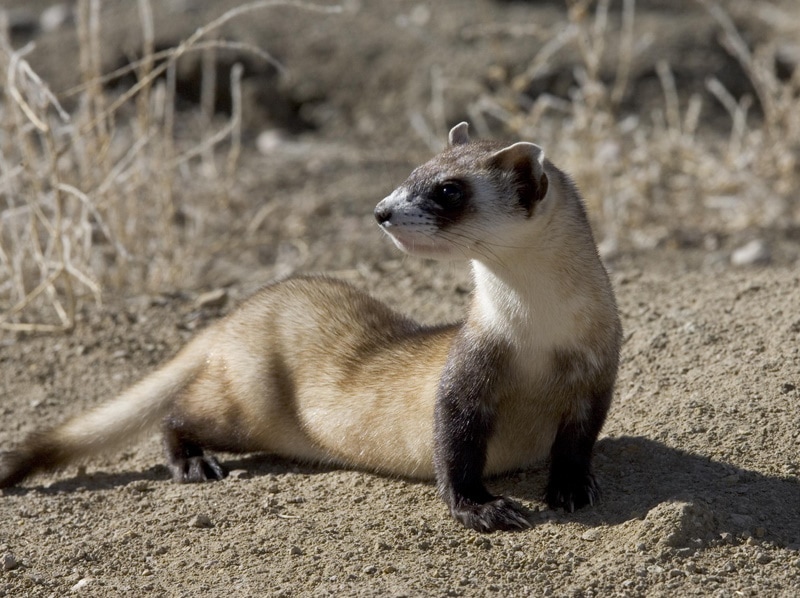Flea Treatment for Ferrets: Vet-Approved Guide

By Misty Layne
Updated on

Ferrets are exceptionally fun pets to have in the home. They’re a bit more unique than just a dog or cat and extremely playful. What isn’t fun is when your ferret gets fleas. No matter what animal you’re a parent of, fleas are an annoyance of the highest order. But how do you treat fleas on a ferret? Is it similar to how fleas are treated on dogs and cats?
We’re here with a step-by-step guide to walk you through how to do a flea treatment for ferrets. Flea treatments will take a bit of time to fully get rid of fleas (especially if they’ve moved into your home and not just on your pet), but with this guide, you’ll get rid of them sooner rather than later. Keep reading!
Before You Begin
Firstly contact your veterinary clinic for advice on effective and safe flea control products for your ferret.
You’ll need a handful of items to help treat your ferret for fleas, so be sure to grab them before you begin your flea treatment! You’ll need:
- Dish soap
- Flea comb
- A towel
- Vacuum
- Steam cleaner
- Cleaning supplies
- Flea treatment for the home
- Flea cleaning solution for cage
- Species and weight appropriate flea treatments for your ferret and any in-contact pets. This includes any animals that have been in contact with the ferret or the house/bedding/cage that the ferrets are kept in.
A Step-By-Step Guide for Treating Fleas on Your Ferret
If your ferret has fleas (something that is more likely to occur if they live with a dog or cat), you want to get rid of the fleas as quickly as possible.
Here’s what you need to do:
1. Speak to Your Vet
The first thing you want to do before anything else is speak to your vet about a ferret-safe flea medication that can prevent future fleas. After you get rid of this round of fleas, you certainly don’t want them to come back, and preventive flea medication is the best way to accomplish that. However, many flea medications are not safe for ferrets so it’s vital to speak with your veterinarian about what medication should be used with your pet. Apply the flea treatment spot-on to your ferret as shown by your veterinarian. Make sure you also treat any in-contact animals with a treatment that is suitable to their species, weight and age. Your vet will be able to advise you here.

2. Clean Your Ferret Friend
Once your ferret is treated, don’t touch the neck area where the medication was applied for 24 hours. After this, you can run a flea comb through your ferret’s coat. Begin at your pet’s head, then work your way down to the tail. This should pull off any fleas that survived (and any dead fleas), ensuring your pet is flea free. Keep your ferret in a temporary house until their enclosure has been cleaned and treated.
3. Clean Their Cage
Now start with your ferret’s cage—remove any bedding, toys, etc. and toss them in the wash for a hot cycle. . Then scrub your pet’s cage with a ferret-safe cleaning solution or hot, soapy water. If you use a cleaning solution, rinse the cage well afterward. Be sure to keep your ferret away from the cage while cleaning it and until the cage and bedding have dried.

4. Vacuum
After your ferret and its belongings have been sufficiently cleaned, it’s time to clean your home to get rid of any fleas or flea eggs! The first step is to vacuum well (get rid of the vacuum bag once this is done) and sweep and mop any hard floor, especially dark, warm corners of the room where fleas like to hide. Steam-cleaning carpets can be very effective at killing eggs and larvae.
5. Apply Flea Treatment Spray Over Your Furniture
Now, it’s time to spray furniture like your sofa, mattresses, and anything made of fabric that cannot be washed, with a flea treatment spray; your ferret will need to be kept far away from these items for a couple of days until the chemicals from the treatment have dissipated. Make sure all animals are removed from the room being sprayed and open windows. Continue to vacuum once daily for a week after the spray has been applied. Repeat the house spray 2-4 weeks later to kill off any fleas that were pupae (not killed by the spray) at the time of the last spray.

6. Cleaning Consistency
For best results, continue washing bedding and vacuuming/cleaning floors once a week for the next month or so.
7. Prevention is the Key
Make sure you treat pet dogs and cats monthly for fleas, as they are usually the culprits for bringing fleas into the house and transmitting them to your ferrets. Routine flea treatment for ferrets isn’t recommended.
Conclusion
And there you have it—a step-by-step guide on how to treat your ferret (and home) for fleas! It’s a bit of work going through all the steps, but once you’ve completed them, your pet and home should be flea-free. You’ll want to keep an eye out in the future for any repeat flea infestations, but if you’ve treated all your animals and the house, the fleas will hopefully not return. Now you and your ferret can enjoy each other’s company without fear of being bitten by fleas!
Featured Image Credit: Irina Vasilevskaia, Shutterstock












